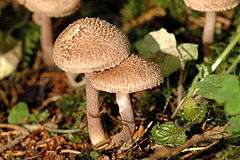Inocybaceae
| Inocybaceae | |
|---|---|
 | |
| Inocybe lanuginosa | |
| Scientific classification | |
| Kingdom: | Fungi |
| Division: | Basidiomycota |
| Class: | Agaricomycetes |
| Order: | Agaricales |
| Family: | Inocybaceae Jülich (1981) |
| Type genus | |
| Inocybe (Fr.) Fr. (1863) | |
| Genera | |
The Inocybaceae are a family of fungi in the order Agaricales. Members of this family have a widespread distribution in tropical and temperate areas.[1]
Taxonomy
The type genus of the Inocybaceae, Inocybe, had traditionally been placed within the Cortinariaceae family.[2][3] Despite this, Jülich placed the genus in its own family, the Inocybaceae.[4] Later, the Cortinariaceae were shown to be polyphyletic.[5][6] Additionally, phylogenetic analyses of RPB1, RPB2 and nLSU-rDNA regions from a variety of Inocybe and related taxa would support Jülich's recognition of Inocybe at the family level.[7] In their Dictionary of the Fungi, Kirk et al. (2008)[8] did not distinguish between Inocybaceae and Crepidotaceae, but rather merged them into one family they called Inocybaceae. The literature has since then split up the classification given by Kirk et al. (2008)[8] into not only Inocybaceae and Crepidotaceae, but also Tubariaceae[9][10][11] and Chromocyphellaceae.[12]
See also
References
- ↑ Cannon PF, Kirk PM (2007). Fungal Families of the World. Wallingford, UK: CABI. p. 176. ISBN 0-85199-827-5.
- ↑ Singer, Rolf (1986). The Agaricales in Modern Taxonomy. Koenigstein, Germany: Koeltz Scientific Books. ISBN 3-87429-254-1.
- ↑ Bisby, Guy Richard; Ainsworth, G. C.; Kirk, P. M.; Aptroot, André (2001). Ainsworth & Bisby's Dictionary of the Fungi / by P. M. Kirk... [et al.]; with the assistance of A. Aptroot... [et al.] Oxon, UK: CAB International. p. 255. ISBN 0-85199-377-X.
- ↑ Jülich W. (1982). Higher taxa of Basidiomycetes. Bibliotheca Mycologia 85. Cramer, Vaduz. 485 pp.
- ↑ Moncalvo JM, Lutzoni FM, Rehner SA, Johnson J, Vilgalys R (2000). "Phylogenetic relationships of agaric fungi based on nuclear large subunit ribosomal DNA sequences". Systematic Biology. 49 (2): 278–305. doi:10.1093/sysbio/49.2.278. PMID 12118409.
- ↑ Moncalvo JM, Vilgalys R, Redhead SA, Johnson JE, James TY, Catherine Aime M, Hofstetter V, Verduin SJ, Larsson E, Baroni TJ, Greg Thorn R, Jacobsson S, Clémençon H, Miller OK (2002). "One hundred and seventeen clades of euagarics". Molecular Phylogenetics and Evolution. 23 (3): 357–400. doi:10.1016/S1055-7903(02)00027-1. PMID 12099793.
- ↑ Matheny PB (2005). "Improving phylogenetic inference of mushrooms with RPB1 and RPB2 nucleotide sequences (Inocybe; Agaricales)". Molecular Phylogenetics and Evolution. 35 (1): 1–20. doi:10.1016/j.ympev.2004.11.014. PMID 15737578.
- 1 2 Kirk PM, Cannon PF, Minter DW, Stalpers JA (2008). Dictionary of the Fungi (10th ed.). Wallingford, UK: CAB International. p. 340. ISBN 978-0-85199-826-8.
- ↑ Vizzini A (2008). "Novitates. Tubariaceae fam. nov.". Rivista di Micologia. 51: 174.
- ↑ Matheny PB, Curtis JM, Hofstetter V, Aime MC, Moncalvo JM, Ge ZW, Tang ZL, Slot JC, Ammirati JF, Baroni TJ, Bougher NL, Hughes KW, Lodge DJ, Kerrigan RW, Seidl MT, Aanen DK, DeNitis M, Daniele GM, Desjardin DE, Kropp BR, Norvell LL, Parker A, Vellinga EC, Vilgalys R, Hibbett DS (2006). "Major clades of Agaricales: a multilocus phylogenetic overview". Mycologia. 98: 982–995. doi:10.3852/mycologia.98.6.982. PMID 17486974.
- ↑ Matheny PB, Moreau PA, Vizzini A, Harrower E, De Haan A, Contu M, Curti M (2015). "Crassisporium and Romagnesiella: two new genera of dark-spored Agaricales". Systematics and Biodiversity. 13 (1): 28–41. doi:10.1080/14772000.2014.967823.
- ↑ Petersen G, Knudsen H, Seberg O (2010). "Alignment, clade robustness and fungal phylogenetics — Crepidotaceae and sister families revisited". Cladistics. 26: 62–71. doi:10.1111/j.1096-0031.2009.00279.x.